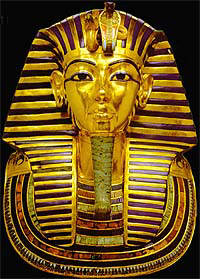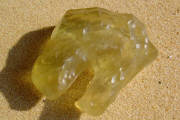

|
SILICA GERMAN |
|
SILICA PICTURES |
|
SILICA ENGLISH |
|
SILICA GEMS |
|
HOME |
|
GERMAN TEXT BELOW |
|
THE STONE OF TUTANCHAMUN |
|
When Howard Carter discovered the tomb of Tutanchamun in 1922, there was a sculpture of jewels and gold surrounding a scarabeus in its center, sybolizing the cosmology of ancient Egyptians, illustrating the young sun-god as a scarabeus with the wings, feet and tail of a falcon. Forelegs and the tips of the wings carry the Eye of Horus and the Snakes of Uraeus. |
|
|
|
The piece of jewellery symbolizes the cosmic order to all living thins and the cycle of life. The scarabaeus itself consist of a greenish-shimmering stone which is absolutely unique amongst Egyptian jewellery. As Howard Carter could not know any better, he calssified the material as Calcedone. New tests in 1998 proofed that the scarabeus was cut out of silica glass. |
|
|
|
Even before the Pharao's, Silica Glass was used at prehistorical times for arrowheads or other sharp weapons and tools. |


|
DER STEIN DES TUTANCHAMUN |
|
Als Howard Carter im Jahre 1922 das Grab des Tutanchamun entdeckte, fand er ein Pektoral, mit Edelsteinen und Gold umrandet. In dessen Zentrum einen grün schimmernden Skarabäus. Das Pektoral stellt den jungen Sonnengott als Skarabäus mit Flügeln eines Falken dar. Die Vorderbeine des Skarabäus sowie die Flügelspitzen tragen das Auge des Horus und die Schlange von Uraeus. Dieses Schmuckstück symbolisiert die kosmische Ordnung sämtlichen Lebens und den Lebenszyklus wie ihn die alten Ägypter verstanden. |
|
|
|
Der Skarabäus in diesem Pektoral ist einmalig. Es sind keine weiteren Schmuckstücke im alten Ägypten bekannt, welche aus Silica-Glass hergestellt wurden. |
|
|
|
Carter vermutete, dass der Skarabäus aus Calcedone ist. Dies wurde wie bekannt 1998 jedoch wiederlegt. Der Käfer ist eindeutig aus Silica Glass gearbeitet. Silica Glass war übrigens nicht erst den Pharaonen ein Begriff. Bereits in der Steinzeit wurden aus dem Glas Pfeilspitzen, Schneidegeräte und andere Werkzeuge hergestellt. |

|
SILICA GERMAN |
|
SILICA PICTURES |
|
SILICA ENGLISH |
|
SILICA GEMS |
|
HOME |